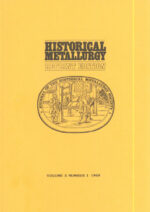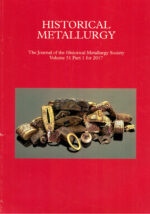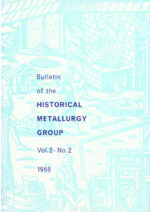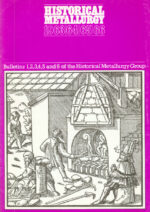Journal Contents
Recent discoveries and excavations of 6th -2nd century BC furnaces in SW Germany
Guntram Gassmann
Pages 71-76
Fieldwork and excavation have given new evidence for Celtic iron production in southwest Germany. Two types offiimace have been recognised, both new to the upper Rhine region. Examples of each type of furnace have been excavated and dated. The later type, of the 3rd-2nd cenUiry BC, had a conical shaft over a slag pit, in which blocks of slag accumulated. The earlier type, of 6th—4th century BC date, had a large diameter cupola-shaped chamber, topped by a narrower shaft. It is suggested that this type may have been operated by natural draught. These cupola furnaces may have been a prototype for the large diameter domed furnaces which occur in several regions of Europe in Celtic and Roman times.
Atxhaeometnc investigations of eagle-head buckles from Bulgaria
I Kuleff, M Junk and L Vagalinski
Pages 77-83
Eagle-head buckles (Adlerkopfschnallen) are among the artefacts from the final stage of the Migration Period. Different types of eagle-head buckles were worn during the 5th-7th centuries AD, mainly by east germanic tribes. The elemental composition of eight buckles has been determined using ED-XRF. The results show that buckles were produced from brass (with 12-25% zinc). Two of the analysed objects are characterized by extremely high silver contents (10—15%). Some aspects of the production technology are elucidated on the basis of results of metallographic investigations.
Tin smelting slags from Crift Farm, Cornwall, and the effect of changing technology on slag composition
A Malham, J Aylett, E Higgs and J G McDonnell
Pages 84-94
Tin-smelting slag from an early medieval site at Crift Farm in Cornwall was analysed using SEM/EDS. A comparison was made between the chemical composition of this slag, which was produced by a simple hand-blowing technology, and slag from seven tin-working sites of later date which employed a more sophisticated water-powered blowing-house technology. The chemical compositions of areas within single pieces of slag were found to be highly variable. This is suggestive of a highly viscous material, with little mixing during smelting. The Crift Farm slag was found to have a chemical composition sufficiently similar to the later ‘blowing house’ slags that it could not be distinguished from them by this method of analysis.
Agricola and Zwickau: theory and practice of Renaissance brass production in SE Germany
Marcos Martlnon-Torres and Thilo Rehren
Pages 95-111
The technology of brass production in the Renaissance has received only little attention so far. This paper concentrates on late 15th-century brass production by studying crucibles recovered in Zwickau (SE Germany). Their scientific analysis by optical microscopy, ED-XRF and SEM-EDX is presented in conjunction with a little known text on brass making written by Agricola in the mid 16th century. As a result, two main crucible types are defined: one big lidded pot used for brass making via cementation, and one smaller triangular vessel used for the melting and casting ofthefi-esh brass produced in thefoimer type. The particular compositional characteristics and slag remains identified in each type of ceramic (big crucibles, lids, and small crucibles) are discussed in the light of their specific function and the diverse technical requirements that they had to meet. All in all, the archaeological picture almost exactly matches Agricola’s account, while it adds further information as to the technical details of the brass making process.
An historical account of iron smelting in the Lowveld, South Africa
Duncan Miller, Maanda Mulaudzi and David Killick
Pages 112-121
In 1930 Mrs E D Giesekke, the wife of a missionary, published an account of indigenous charcoal manufacture, iron mining, smelting and smithing in the Lowveld region of northern South Africa. Despite earlier mention of iron and copper working in the area around Phalaboviva by European travellers and explorers, Mrs Giesekke’s account is the only known detailed description of the smelting process and rituals associated with it. This paper is an annotated translation of Mrs Giesekke’s account from the original German, including a translation of one of the smelters’ songs recorded by her. This complements recently completed archaeometallurgical analyses of smelting debris from the Phalaborwa area.
A practical treatise on the smelting and smithing of bloomery iron
Lee Sauder and Skip Williams
Pages 122-
For several years, we have explored many aspects of the process ofbloomery smelting in a shaft furnace. In contrast to most attempted reconstructions of bloomery smelting, our work has focused on the process itself rather than its archaeological signatures. This paper describes a typical smelt of the most efficient regimen we have yet discovered. We will pay particular attention to methods that differ fi’om those of most experimenters, especially with regard to blowing rate, slag management, and the recycling of furnace products. A bloomsmithing experiment is also described, and yields, resources, and labour requirements are quantified. We then offer a few observations where our experience differs from what we have read in the literature. Finally, we suggest that these methods, when applied to archaeological reconstructions of ancient bloomeries, may provide some missing answers for the archaeometallurgical community.






There are no reviews yet.